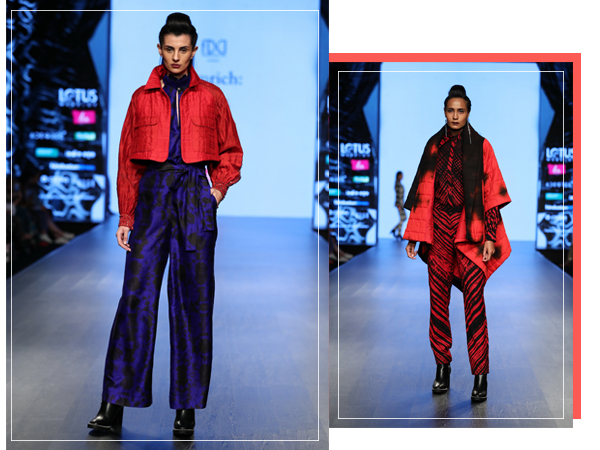The sari is one of the few pieces of ancient art, which withstood the turbulent Indian history and the western influences that came with it. In conversation with the industries leading designers, about this infallible traditional creation and its relevance in a modern context.
By Asmita Aggarwal
The simple sari, with its many regional interpretations, has proven to be a 6-yard-long, unstitched piece of living culture. Its presence throughout periods of history, otherwise centuries apart, is a testament to its timelessness. From its potent imagery in the Vastraharan, the event that sparked the beginning of the Mahabharata, to its seductive representation in Satyajit Ray’s film ‘Charulata’, the sari has not only been a part of the Indian wardrobe but also lies at the heart of India’s cultural zeitgeist.
Indian fashion designer, Rina Dhaka says, “Besides the flattering qualities of a saris silhouette, I appreciate it for its strong culture. The craft of creating a sari provides livelihood to generations of craftspeople. Whether it’s the saris adaptation by the experimental youth, its utilitarian form imbibed by the working woman on the streets, or its illustrious renditions by the royals– the sari unifies an extremely diverse country.”
As with every existential crisis, the traditional sari cannot ignore the modern context it struggles to remain significant in. Textile designer Peter D’ascoli addresses this reality. “The cultural identity associated with a sari is of strong traditionalism, and at the same time, western silhouettes are becoming associated with modernity. It is because of globalization, that not India, but the whole world is facing a grave loss of cultural diversity in all forms – cuisine, regional dress, language and textile. In order to survive, one must evolve,” he says.
It is this process of evolution that designers strive to contribute towards, using a variety of different strategies, one being that of Payal Jain’s. “If I were to recreate a kimono from Japan or a cheongsam from China, I would preserve the authenticity of that particular silhouette, the same applies to a sari,” she says. The designer expresses her undeterred faith in the unadulterated sari, “For many reasons, be it culture or comfort, everything in our wardrobes has been completely transformed. The sari, however, at its core, remains as beautiful as it has always been. As a country, we are looking at our past to create for our future, in all aspects, be it art, design or architecture.”
From a similar school of thought, comes Pratima Pandey, champion of understated elegance. “The ’60s witnessed the fitting sari, a drastic change in the blouse came in the ’70s, the ’80s experienced a hoard of block prints, and for the two decades that followed, the influence of the west subdued the saris wonder,” she says. Despite this, the designer sees a promising shift of perception towards ethnic wear today. “There is an obvious sense of coming back full circle and being proud of our own culture,” she says. In these circumstances, Pratimavaluesher voice as a designer, and the responsibility that comes with it. “I would work towards bringing the sari back in its most crude and authentic form. In this venture, my efforts will always be towards elevating handlooms, textiles and the communities that depend on them,” she adds.
While some focus on the fabric, Rina Dhaka’s take is a clever play with form. “I have created modern variations of saris, including stretch saris and skirt saris with an inner pull four-way stretch, but regardless of my manipulation of its form, my attempt has always been to retain the look of a tied sari when worn. Holistic, simple and ready to wear,” she says.
Medha Khosla of Anomaly, adds detail to this philosophy of functionality. “A few years ago, the pocket wasn’t given much importance on dresses and skirts. Now, we can’t do without it,” she says.Expert in minimal office-wear further explains, “I believe that function and tradition can go hand in hand. This is why we are seeing designers experiment with petticoats, blouses and creating pre-stitched saris.”
AnavilaMisra is one such designer, who in four years managed to bring back the glory of the traditional draped sari with her signature linen creations. This designer managed to retain the classicality of the garment and further, give it her own subtle contemporary twist in the form of daring drapes and pocketed petticoats.
Another stand out effort towards driving the modern millennial customer back home was that of DikshaKhanna’s, who experimented with metallic yarn inserts with handloom khadi denim. “Today, the key lies in striking a balance between being contemporary, fuss-free and yet traditionally rooted in India’s textiles and surface techniques,” says Khanna.
At the other end of the spectrum, there is the eclectic Anushree Reddy, who works towards satisfying a very different customer base with her dainty ensembles. “For my recent collection, we did saris on organza with classic threadwork and cutwork. Emerging from the cutwork was a petticoat with a net frill. We did ruffle blouses with a heavy sari as well. Evolution is necessary within every plane of the multi-faceted market,” she says.
While the industries best roll up their sleeves and get to work to ensure a longer lifespan for the sari, ShrutiSancheti hits pause and raises a reasonable concern. The designer calls for introspection. “An influx of new interpretations of saris blend western sensibilities of tailoring, and kill the original essence of the sari,” she says. She raises the question of whether this evolution of design, however well intended it may be, is forgetting about the very basics that this age-old wonder is known for – simplicity.
She turns her attention away from the designer, and towards the customer, “To revive and reinforce the sari, awareness has to be created amongst Indian woman and the world, that the sari is not an exotic item of dressing or occasion wear.” The designer asks for a collective effort towards embracing the sari for its ability to accentuate a woman’s features, rather than as an exotic item of dressing. “One needs to embrace the sari not only as occasion wear but as a garment that can work in any context – climatic, social and cultural,” she adds.


















 PC : Diya Mathur
PC : Diya Mathur





















